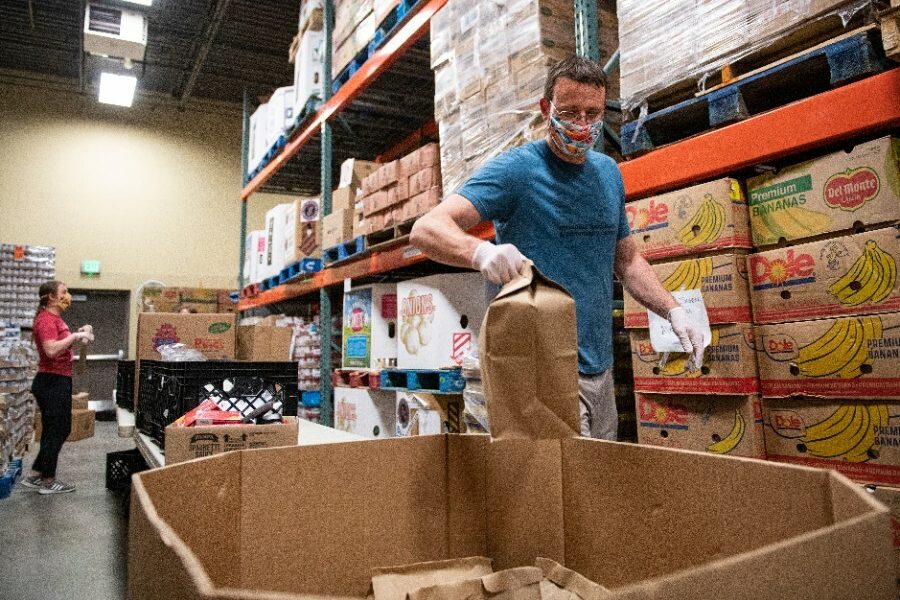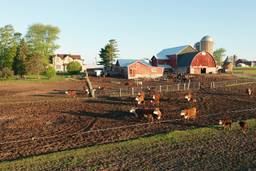In Montana, Food Banks Battle Surging Demand and Shifting Supply Chains
Joseph Bullington

Editor’s Note: This article is published in collaboration with Montana Free Press.
Brent Weisgram was too swamped to do a phone interview.
As chief operations officer, he oversees food purchasing and distribution for the Montana Food Bank Network, headquartered in Missoula, and his troubles can be summed up in a few figures, which he sent in an email.
MFBN has shipped 1.6 million meals to Montana food pantries in the last month ― half a million more than during the same period last year. And as need has surged, so has the price of certain staples. A case of peanut butter, for example, currently costs about 45% more than usual.
The numbers illustrate how the COVID-19 pandemic, which has pushed tens of thousands of Montanans out of work and sent shudders through commercial and retail supply chains, has hit food banks from both sides.
MFBN distributes food to 167 partners across the state, and Chief Programs Officer Stephanie Stratton said many local pantries have seen surges in need. At rural pantries, Stratton said, the increase has so far been more modest than MFBN expected ― between 10 and 20%. At pantries in the “big seven” Montana cities, meanwhile, need has surged by 30 to 60%.
Visits to the Food Resource Center in Livingston have increased by 300% since mid-March. In the last two weeks of March alone, the Missoula Food Bank provided food to 500 households that had never used the resource before.
“Based on what we’re seeing locally here in Missoula, it’s mostly service industry workers who have been laid off or had their hours cut,” Stratton said. “Maybe they were doing OK before, living paycheck to paycheck, but this thing pushed them over the edge.”
Besides putting people out of work, the closures of schools, restaurants, bars and other businesses have had another important impact on food pantries: The closures have slackened demand for food from the commercial supply chain. Meanwhile, more people are eating at home and stocking up on groceries, which has stressed the consumer supply chain that stocks grocery stores. Food security nonprofit Feeding America’s grocery rescue program, which diverts food that is approaching its sell-by date to food banks, has dried up because, as Stratton put it, “there was nothing left on the shelves for the grocery stores to donate.”
For food banks, the results have been mixed: The MFBN warehouse, for example, is awash with milk, which would normally have been sold to schools, and even has plenty of fresh produce, but has struggled to maintain supplies of some non-perishable food-bank staples. Food from the commercial supply chain can be repackaged into family-sized quantities, but that takes time. So, according to Weisgram, if he needs canned vegetables or canned tuna or peanut butter or frozen ground beef and he places orders six to eight weeks out, he can get those foods at roughly pre-pandemic prices. If he needs them in three to six weeks, he pays 30 to 45% more, he said.
Increased food need and increased costs mean MFBN, which is funded solely by donations and grants, is spending more money. So far, Stratton said, financial donors have been generous, but she’s not sure they’ll be able to sustain their current level of giving.
“It’s all brand-new territory,” she said. “I don’t think we could keep up this pace long-term.”
* * *
Food banks were never meant to be a long-term solution to hunger in America, as Nicholas Kulish points out in a New York Times article. The idea was born in Phoenix, Arizona, in 1967, spread nationwide in the 1970s, and continued to grow in the early 1980s as the economy went into recession and President Ronald Reagan cut social support programs. Even today, the importance of food banks is dwarfed in comparison by the Supplemental Nutrition Assistance Program (SNAP), the federal program formerly known as food stamps, which provides about nine meals for every one provided by food banks nationwide.
Aaron Brock, executive director of the Missoula Food Bank and Community Center, said he’s seen the impact of the federal resource on food assistance demand firsthand.
In Brock’s account, the coronavirus crisis hit Montana in mid-March, a couple of weeks before Gov. Steve Bullock’s stay-at-home order was implemented. The Missoula Food Bank instituted a new model of operations on March 16: Volunteer shifts were suspended in favor of a “lean team that’s working really hard,” and pre-packed, grab-and-go boxes were offered in place of the usual grocery-store model ― all to limit the number of people in the building at one time and maintain social distancing.
The next two weeks were “extremely busy,” Brock said ― 50% busier than usual, with 200 households per day picking up food. Since then, demand has tapered off, to the point that now the pantry is only about 10% busier than its pre-pandemic standard. Brock attributes the slowdown to people becoming eligible for full SNAP benefits and receiving their $1,200 stimulus checks.
The problem, Brock said, is that federal support won’t last.
“I think that we will be busier a month from now than we are today,” he said. “Our anticipation is that these benefits will expire before the economic situation [resolves]. If you have a very modest rental in Missoula, that [$1,200] pays for maybe a month, a month and half.”
To meet increased demand over the last month, the Missoula Food Bank and Community Center has had to spend more money, but so far that expense has been matched in donations.
“Of all the things we’ve been worrying about, buying food has not been one of them,” Brock said. “If this goes on for an extended period, that’s a different scenario.”
But Brock doesn’t want anyone to worry that the pantry is going to run out of food.
“There’s no need for people to worry that we’re not going to have food tomorrow,” he said.
* * *
Michael McCormick, director of the Livingston Food Resource Center (LFRC), thinks some of the supply chain problems are symptomatic of a food system that wasn’t very healthy in the first place.
Before the pandemic, LFRC served 300 to 350 households in an average month. Now, McCormick said, it’s serving almost that number every week.
“A lot of the growth we’re seeing is coming from one place,” he said. “It’s young families, with kids, who’re recently unemployed.”
The pantry, which has shifted to a curbside-pickup model, has added a “family distribution night” to try to keep up with the new demand, while also meeting the needs of the elderly participants in its Senior Supper Club, 75% of whom live alone.
“When demand changes and shifts ― in this case it just exploded ― it sucks all the food out of the system all the way back to the warehouse,” McCormick said. “What we’re seeing right now is a product of not having well-developed local food systems.”
Under Gov. Steve Bullock’s phased reopening plan, restaurants and schools will be allowed to begin to re-open starting May 4 and May 7, respectively. But because of the closures, many small and mid-sized local farms have already lost part of their market, and McCormick hopes food pantries can be part of the solution to that, too.
“I want food pantries to be a new market for local farmers,” he said. “Basically, I want to invest in our local food systems.”
And, he said, food pantries need to be thinking long-term, especially in places like Livingston, where the tourism-dependent economy could be particularly sensitive to pandemic effects.
“We’ve got businesses that are closed now that I don’t think will ever re-open,” he said. “You don’t rebuild that in a couple of months.”
SPECIAL DEAL: Subscribe to our award-winning print magazine, a publication Bernie Sanders calls "unapologetically on the side of social and economic justice," for just $1 an issue! That means you'll get 10 issues a year for $9.95.
Joseph Bullington grew up in the Smith River watershed near White Sulphur Springs, Montana. He is the editor of Rural America In These Times.






